Spelt Sourdough Bread is an easy overnight recipe that tastes nutty and a little sweet. Fresh rosemary adds a smooth herb flavor. This spelt bread recipe has a crusty exterior and a soft tender center. Exactly what you look for in artisan bread.
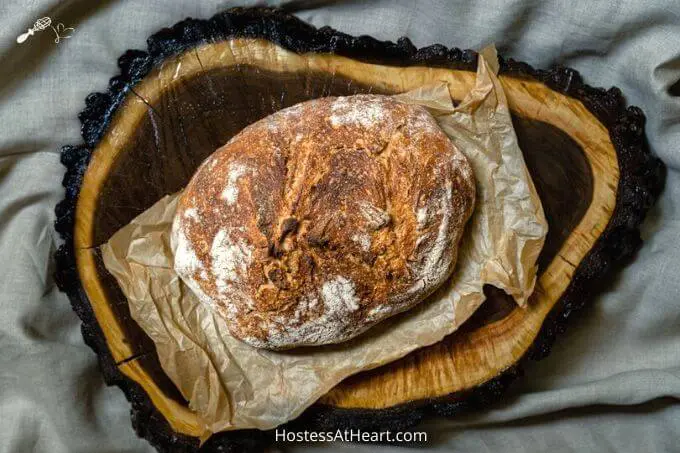
Spelt Sourdough Bread recipe is an easy bread to create. This smooth nutty bread has a wholesome flavor that goes perfectly with about any meal.
It’s delicious fresh out of a hot toaster with a slather of butter and it also makes an amazing turkey sandwich!
I get comments about ideas for products or gifts for a bread baker that would be helpful if someone wanted to get started baking artisan-style bread.
I put together a list and asked what bread you’d like to see made here on Hostess At Heart and received some amazing requests that I’m working on.
One of the requests that I couldn’t wait to tackle was for a Spelt Flour Bread Recipe.
I’ve made a Spelt bread recipe before so I knew how amazing it tastes, but it’s for a quick sandwich loaf. This recipe request was for a Spelt Sourdough Bread recipe.
What is Spelt?

Spelt is an ancient whole grain in the wheat family but is not wheat!
The benefits of using spelt flour
I’ve read that spelt has less gluten than wheat and some gluten-sensitive people can tolerate it. I would use caution here however because it does contain gluten. People with celiac disease shouldn’t consume spelt.
I bring up gluten in spelt because it is more fragile than in wheat flour. For this reason, it acts differently than wheat flour in baking.
I’ve found that spelt flour on its own will deflate or flatten once it’s removed from the oven in my quick bread recipes. I haven’t baked a 100% spelt flour loaf of bread.
For that reason, I combine spelt flour with other flour such as bread flour or white flour. Using a mix of flour still allows the spelt flavor to shine.
Spelt flour comes in several varieties. We used whole grain, stone-ground flour in this recipe.
I found this resource helpful in tips for using spelt flour.
I used a different technique for rising this spelt bread recipe compared to our Overnight Sourdough Bread and Multi-grain Wheat Bread recipes. It still has minimal handling, but after a countertop rest like the other bread recipes, I put it in the refrigerator for a slow overnight fermentation.
I use this method with some of my other artisan bread and like the flavor it takes on.
How to make Spelt Sourdough Bread
I made adjustments to the flour mix and the water ratio. Spelt absorbed the water so this bread has is higher in what’s called “hydration” than some of our other sourdough bread recipes.
Hydration is the ratio of flour to water. For example, we use a total of 500 grams of flour in the recipe and 375 grams of water so the hydration is 75% (500/375).
Don’t get hung up on the math stuff since I’ve done it for you. As you can see in the first picture below, this is a wetter dough.
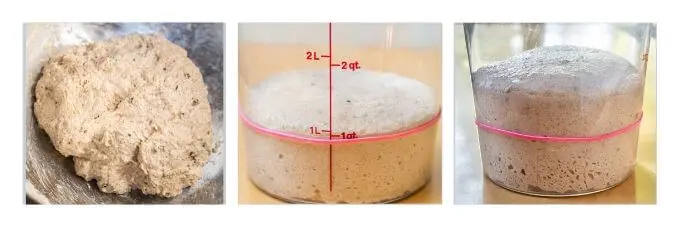
- Squelch all of the ingredients together.
- Place the dough in a container that you can measure its progress. I have several rising buckets in several sizes, but a bowl works just fine.
- When dough has doubled, remove it from the container and shape.
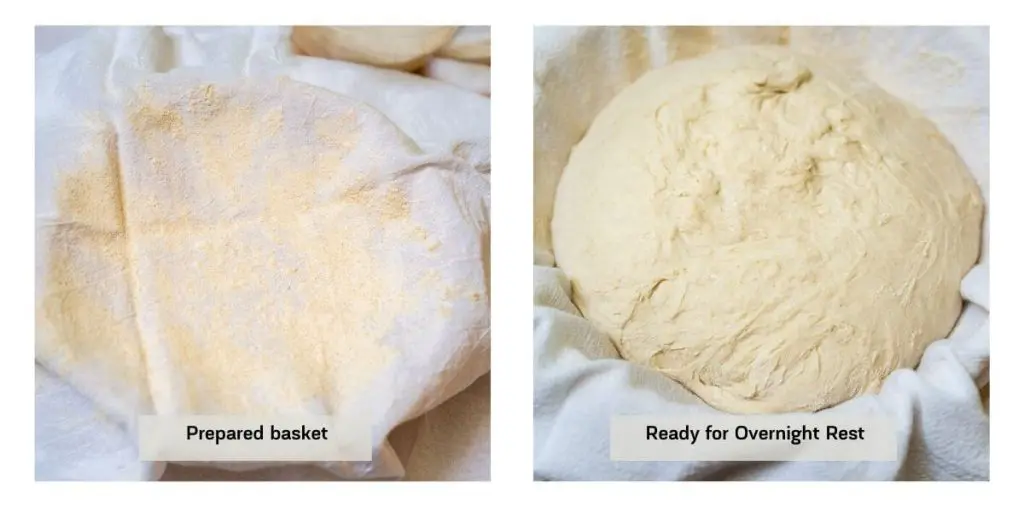
- Prepare a bowl, basket (banneton) by dusting it with flour. I use a 50/50 mix of white whole wheat with rice flour. Use what you have.
- Place the shaped dough, seam side up in the prepared bowl or basket. Cover the dough and place it in the refrigerator for up to 12 hours. I’ll put the whole basket in a plastic grocery bag.
- Bake as instructed in the recipe card below.
If you would like to see how I get the dough into a hot pot without ruining the shape of the bread or burning myself, I’ve got a “how-to” video on my Wheat Bread post.
Hostess At Heart participates in affiliate programs. As an Amazon Associate, I earn a commission from qualifying purchases. Please refer to my disclosure page for more information.
Products that I use to make Spelt Sourdough Bread
- Dutch Oven – I have several enameled cast-iron dutch ovens. I started out with a few that cost about 4 times what this one does and it’s my favorite! I make my sourdough bread in it and it’s perfect for soups, stews, and so many other things. It cleans up like a dream too!
- Parchment Paper – This is my favorite parchment paper. It’s important to know that there is an oven temperature rating on parchment paper. If you exceed it your parchment paper can catch fire in your oven. This one is rated to 450°F, high enough for these bread recipes.
- Oven Mitts – When I work with heavy pots and pans I want an oven mitt versus a hot pad. These mitts are heat rated to 550° so are good for the oven or bbq and come in several colors. They also come in a longer length for longer arms!
Make your own starter
This bread uses a “starter“. You can build your own and have your very own sourdough bread on the table in less than 8 days. Our step-by-step guide takes out all of the mystery.
You could feed your starter with spelt flour instead of the wheat flour used in my starter recipe. However, I don’t think that it makes a difference and I don’t want to maintain several different starters according to the flour used in the bread I’m making.
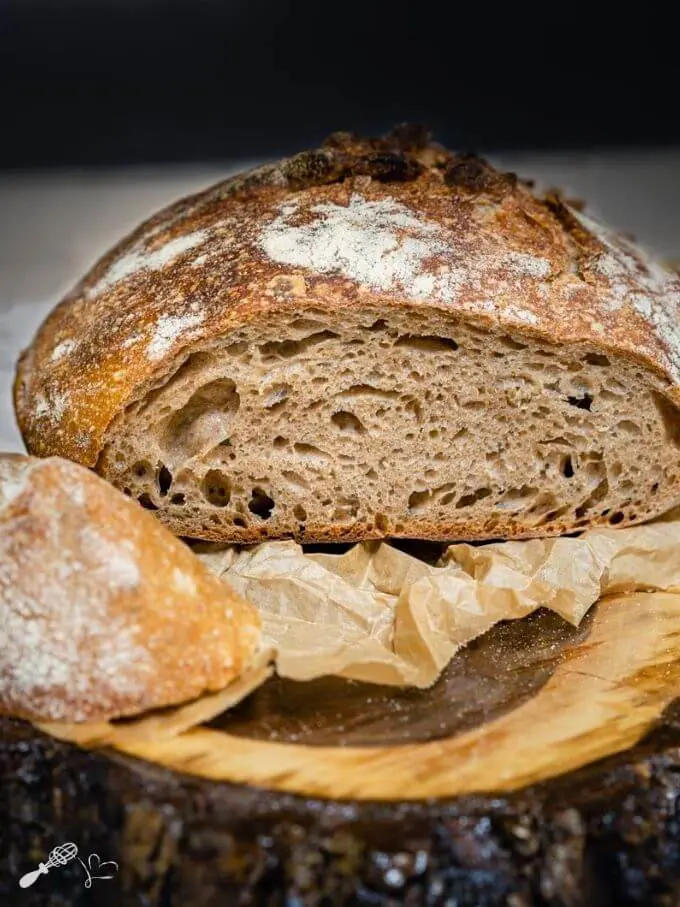
FEED YOUR SOURDOUGH STARTER
Fed starter is also referred to as a “Levain”. Don’t get hung up on the terms. It’s just a fed starter.
We feed our starter before bed by taking 1 tablespoon of starter and mixing it with 200gr filtered water and 200gr of our 50/50 flour mix. It has always passed the float test the next morning which can be 6 to 8 hours.
If you’re making your bread without letting your starter feed overnight, you just have to watch it. It’s ready when it’s increased by about 30% which is about 4 hours for mine. Room temperature and strength can be variables, however.
This makes more starter than what you will need but I bake several loaves at a time and freeze them.
Homemade Spelt Ingredients
- Bubbly starter – We store our starter in the refrigerator between baking days so will feed it for a couple of days before using it to make sure it’s good and active before baking.
- After you feed your starter, wait until it’s increased in volume about 30%. That’s usually about 4 hours for mine but if we’re mixing in the morning can be 6 to 8 hours overnight.
- If your dough is runny it can be because your starter was actually starving when you used it. I have a video showing how to check to see if your Levain is ready to use.
- Salt – I use fine sea salt. It is easier to incorporate and dissolve than coarser salt.
- Spelt Flour – I used organic whole grain, stone-ground spelt flour. It has an amazing texture and sweet nutty flavor.
- Organic Bread Flour – Bread flour has a higher protein content than AP flour. That higher protein provides more structure to your loaf. It worked very well with the wheat flour
- Water – There’s a lot of controversy regarding water in bread making. Some experts say if you can drink it you can bake with it. Other experts say the chlorine and mineral content can inhibit yeast activity.
- Fresh Rosemary – You can substitute for dry or choose another herb. Fresh Thyme would be delicious too. You can also leave them out altogether and it will not affect the final outcome one bit.
This Spelt Sourdough bread came out with that delicious crispy crust and that pull you want in a sourdough loaf. The center was soft and tender with that sweet nutty flavor from the spelt flour and essence from the fresh rosemary.
Other Sourdough Starter Bread recipes
- Overnight Sourdough Bread
- Organic Whole Wheat Bread Recipe
- Spelt Sourdough Bread
- Sourdough Sandwich Bread
- No-Knead Sourdough Bread with All-Purpose Flour
Unlike my other sourdough bread recipes, I didn’t score this loaf prior to baking. Since Spelt doesn’t contain the structure of other flour I didn’t feel it was necessary.
Scoring the loaf prevents a “blow out” or tear while baking. Some bakers like this effect so don’t score any of their bread.
As you can see, this Spelt Sourdough Bread didn’t blow out. It didn’t bake as tall as our other sourdough bread recipes but that was expected.
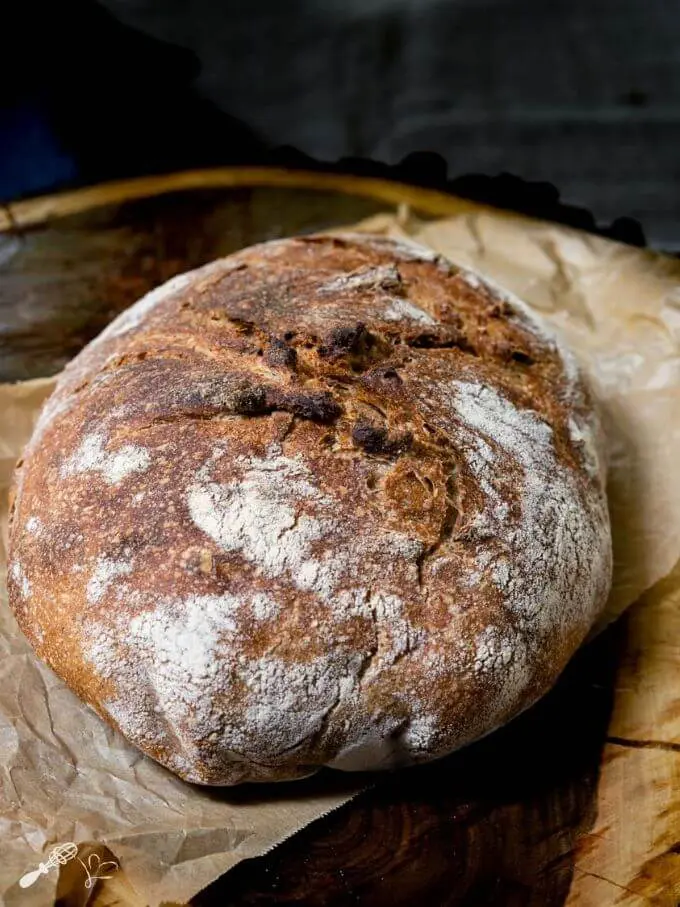
If you hate throwing away sourdough starter discard, you’re going to love these Sourdough Starter Discard recipes!
I want to thank the reader who suggested that we make a spelt bread recipe. I loved it and hope you will too!
I hope you enjoyed this delicious recipe as much as we do. Drop me a comment below, and don’t forget to give it a star rating. ⭐⭐⭐⭐⭐. Your comments and ratings help others decide if this recipe is for them too.
Did you enjoy this recipe? Don’t forget to pin it for later and follow me on Pinterest for more delicious recipes like this one!
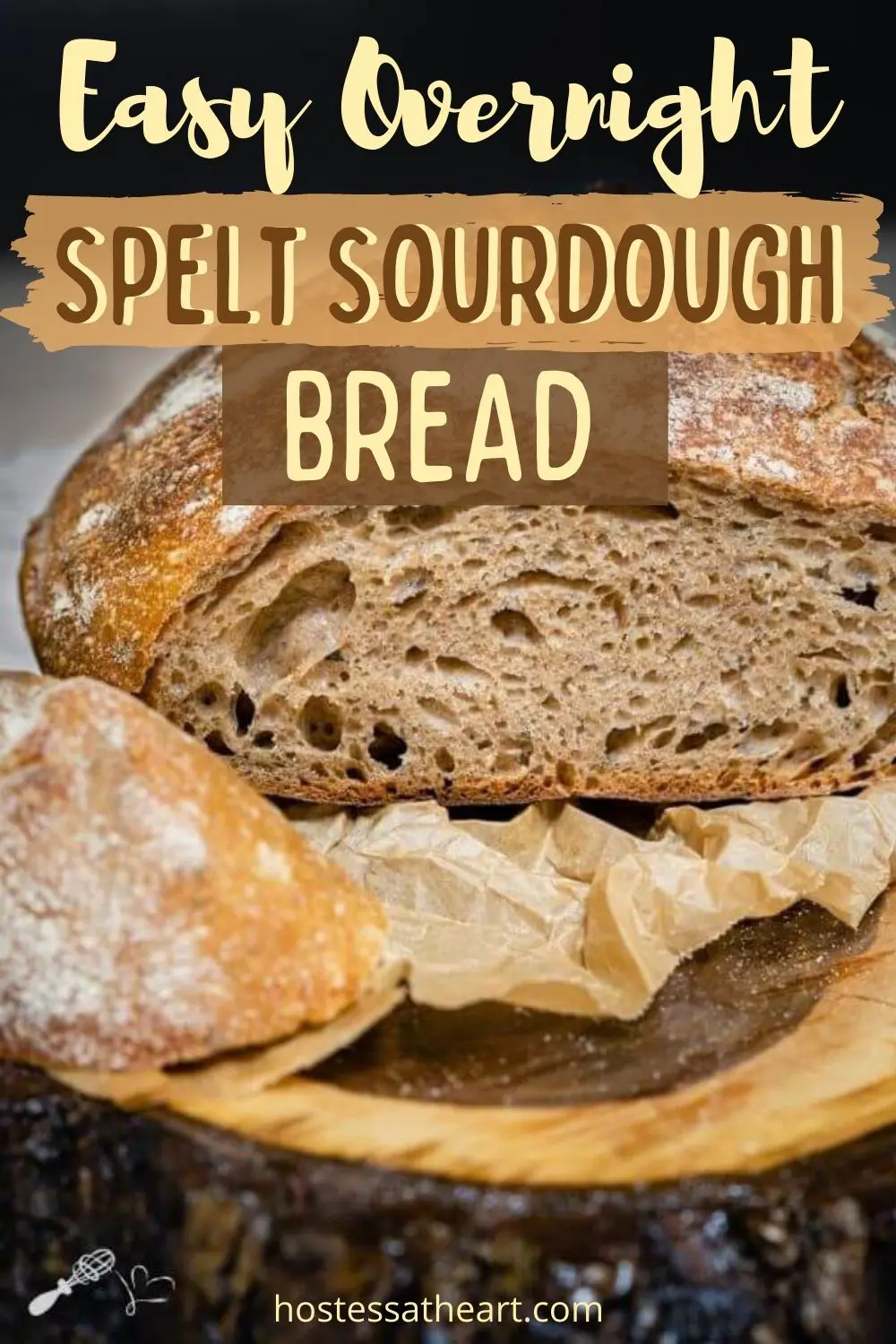
I have a great list of loaves of bread to put together and would love to know if you’d like to have one featured too!




Nicole
Wednesday 17th of April 2024
Hi! In your written recipe you have bench ferment for 6 hours, then shape and into bowl/banneton and overnight in the fridge. Short bench rest in morning whilst oven pre-heats and then bake.
In your video you have the bench rest & overnight rest (you don't specify time or location), and then shape with a short bench rest in the morning prior to baking.
Is it better to shape prior to overnight rest or in the morning just prior to baking? Or do both?
Julie Menghini
Thursday 18th of April 2024
Great question, Nicole. Most of the time I shape it and let it sit out and then refrigerate it overnight. It will maintain it's shape.
Mariana
Thursday 16th of November 2023
Can you use sprouted spelt flour?
Julie Menghini
Thursday 16th of November 2023
I've never used sprouted spelt flour but as long as it's the consistency of spelt flour I wouldn't know why not. If you try it, Mariana, will you let me know how it goes so I can share your experience?
Sydney
Saturday 11th of March 2023
Excellent spelt recipe! My only change was that I did a couple stretch and folds during the 6 hour rising time. Crust was nice and golden and inside had a great texture. Thanks for sharing this!
Julie Menghini
Sunday 12th of March 2023
I love spelt, Sydney, and so glad you enjoyed it. I often do 3 to 4 stretch and folds the first 3 hours for that open crumb that we enjoy. Thank you so much for your comment!
Teashie Cullins
Friday 22nd of July 2022
Is this a one time use? Mine was nice and bubbly but I wasn't able to use it at that time so I discarded and fed it with a 50/50 ratio. Now it is a little bubbly but quite runny. It sinks when I put it in water.I don't dare to use it. Should I throw this away and start again,hoping I am able to use it? I also grind my own spelt berries on demand. Would that make a difference? Thank you. I am excited to try this recipe!!
Julie Menghini
Friday 22nd of July 2022
Great question, Teashie! You need to keep feeding it or refrigerate it between baking. See my post on starters, https://hostessatheart.com/sourdough-discard-recipes/. You'll remove all but about 1 tablespoon and then refeed it. You don't need to keep that much starter in between baking. I hope this helps. If not, just let me know.
LL
Friday 1st of April 2022
Worked beautifully and the rosemary flavor is perfect. I made two loaves at the same time and the amount of rosemary on the cutting board looked as though I trimmed a Christmas tree, but the taste was perfect. Will add roasted garlic next time. Awesome and easy recipe! Thanks for creating/sharing.
Julie Menghini
Sunday 3rd of April 2022
Thank you, LL! I appreciate your comment. The roasted garlic will be amazing!